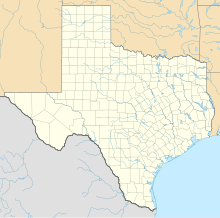Marine Corps Air Station Eagle Mountain Lake
| MCAS Eagle Mountain Lake | |||||||||||||||
|---|---|---|---|---|---|---|---|---|---|---|---|---|---|---|---|
| Summary | |||||||||||||||
| Airport type | Military | ||||||||||||||
| Location | Pecan Acres, Texas | ||||||||||||||
| Coordinates | 33°38′00″N 97°49′00″W / 33.63333°N 97.81667°WCoordinates: 33°38′00″N 97°49′00″W / 33.63333°N 97.81667°W | ||||||||||||||
| Map | |||||||||||||||
| Runways | |||||||||||||||
|
|||||||||||||||
| Marine Corps Air Station Eagle Mountain Lake | |
|---|---|
| Pecan Acres, Texas | |
| Type | Military air station |
| Site information | |
| Controlled by | USMC |
| Site history | |
| Built | December 1, 1942 - December 1946 |
| In use | 1942 - 1946 |
Marine Corps Air Station Eagle Mountain Lake (MCAS Eagle Mountain Lake) was a United States Marine Corps air station that was located 23 miles (37 km) northwest of Fort Worth, Texas during World War II. Commissioned on December 1, 1942 the air station was originally supposed to be the home of the Marine Corps glider program. When the program was cancelled in 1943 the station became home to the newly created Marine Night Fighting Squadrons. After the war the air station went into caretaker status in December 1946 and became an Outlying Landing Field of Naval Air Station Dallas. After the war, it was used by various branches of the military before being sold to a private owner in the 1970s. Today, the airfield is a private airport run by the Kenneth Copeland Ministry as Kenneth Copeland Airport.
In 1942, 2,931 acres (11.9 km2) of former ranch land were purchased on the eastern shore of Eagle Mountain Lake so the Marine Corps could set up glider operations. Construction of the base began on July 24, 1942. Marine Glider Group 71 (MLG-71) and Marine Glider Squadron 711 (VML-711) arrived at the base in November 1942 and the station was officially commissioned on December 1, 1942.
In May 1943, the Marine Corps cancelled its glider program and on June 30, 1943 the base was redesignated a Naval Air Station. The Navy's Strategic Tasks Air Group 2 used the airfield to test newly developed remote control aircraft until 1944 when they were moved to Traverse City, Michigan.
On April 1, 1944 the air station reverted to Marine Corps control by the authorization of CNO Dispatch 31TWX1715. The Air Station's next higher echelon command was Commander, Naval Air Bases, Clinton, Oklahoma. On April 9, Marine Aircraft Group 33 (MAG-33) arrived from Bogue Field, North Carolina. MAG-33 stayed until August 17, 1944 when they left for San Diego, California. In August, Marine Aircraft Group 93 (MAG-93) arrived from Marine Corps Air Station Cherry Point and remained until November. In December the field became the home of Marine Aircraft Group 53 which was the Marine Corps' first night fighter group. From then on the base was used primarily for night fighter training. Two common night fighters that operated from the field were the Grumman F6F Hellcat and F7F Tigercat.
...
Wikipedia

